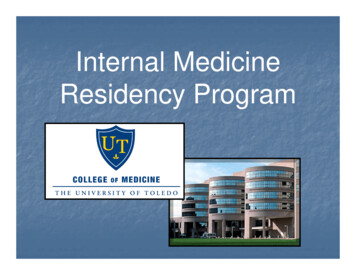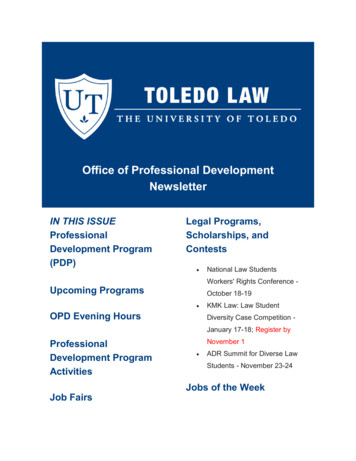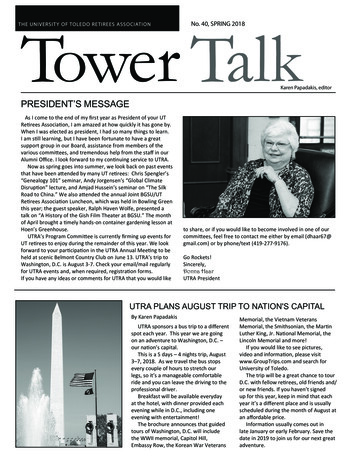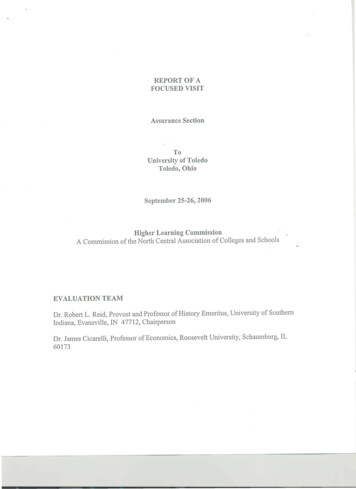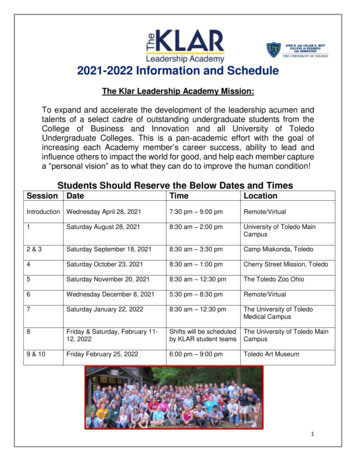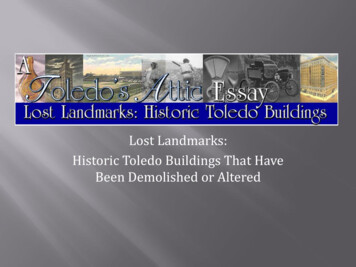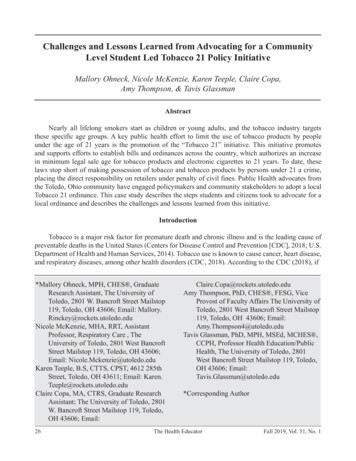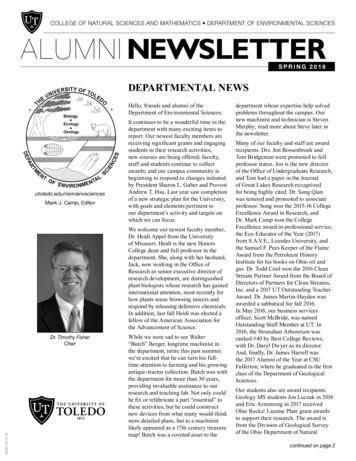
Transcription
COLLEGE OF NATURAL SCIENCES AND MATHEMATICS DEPARTMENT OF ENVIRONMENTAL SCIENCESALUMNI NEWSLETTERSPRING 2018DEPARTMENTAL NEWSHello, friends and alumni of theDepartment of Environmental Sciences.utoledo.edu/nsm/envsciencesMark J. Camp, EditorIt continues to be a wonderful time in thedepartment with many exciting items toreport. Our newest faculty members arereceiving significant grants and engagingstudents in their research activities;new courses are being offered; faculty,staff and students continue to collectawards; and our campus community isbeginning to respond to changes initiatedby President Sharon L. Gaber and ProvostAndrew T. Hsu. Last year saw completionof a new strategic plan for the University,with goals and elements pertinent toour department’s activity and targets onwhich we can focus.We welcome our newest faculty member,Dr. Heidi Appel from the Universityof Missouri. Heidi is the new HonorsCollege dean and full professor in thedepartment. She, along with her husband,Jack, now working in the Office ofResearch as senior executive director ofresearch development, are distinguishedplant biologists whose research has gainedinternational attention, most recently forhow plants sense browsing insects andrespond by releasing defensive chemicals.In addition, last fall Heidi was elected afellow of the American Association forthe Advancement of Science.NSM 84 0418Dr. Timothy FisherChairWhile we were sad to see Walter“Butch” Berger, longtime machinist inthe department, retire this past summer,we’re excited that he can turn his fulltime attention to farming and his growingantique-tractor collection. Butch was withthe department for more than 30 years,providing invaluable assistance to ourresearch and teaching lab. Not only couldhe fix or refabricate a part “essential” tothese activities, but he could constructnew devices from what many would thinkwere detailed plans, but to a machinistlikely appeared as a 17th century treasuremap! Butch was a coveted asset to thedepartment whose expertise help solvedproblems throughout the campus. Ournew machinist and technician is StevenMurphy; read more about Steve later inthe newsletter.Many of our faculty and staff are awardrecipients. Drs. Jon Bossenbroek andTom Bridgeman were promoted to fullprofessor status. Jon is the new directorof the Office of Undergraduate Research,and Tom had a paper in the Journalof Great Lakes Research recognizedfor being highly cited. Dr. Song Qianwas tenured and promoted to associateprofessor. Song won the 2015-16 CollegeExcellence Award in Research, andDr. Mark Camp won the CollegeExcellence award in professional service,the Eco-Educator of the Year (2017)from S.A.V.E., Lourdes University, andthe Samuel F. Pees Keeper of the FlameAward from the Petroleum HistoryInstitute for his books on Ohio oil andgas. Dr. Todd Crail won the 2016 CleanStream Partner Award from the Board ofDirectors of Partners for Clean Streams,Inc. and a 2017 UT Outstanding TeacherAward. Dr. James Martin-Hayden wasawarded a sabbatical for fall 2016.In May 2016, our business servicesofficer, Scott McBride, was namedOutstanding Staff Member at UT. In2016, the Stranahan Arboretum wasranked #40 by Best College Reviews,with Dr. Daryl Dwyer as its director.And, finally, Dr. James Harrell wasthe 2017 Alumni of the Year at CSUFullerton, where he graduated in the firstclass of the Department of GeologicalSciences.Our students also are award recipients.Geology MS students Jon Luczak in 2016and Eric Armstrong in 2017 receivedOhio Rocks! License Plate grant awardsto support their research. The award isfrom the Division of Geological Surveyof the Ohio Department of Naturalcontinued on page 2
COLLEGE OF NATURAL SCIENCES AND MATHEMATICS DEPARTMENT OF ENVIRONMENTAL SCIENCEScontinued from page 1Resources, and valued at 2,000 and 2,500, respectively. Jessica Shermanreceived the best presentation award atthe 2016 Midwest Graduate ResearchSymposium. In May 2016, Caroline Beckwas the outstanding graduating seniorin the department and in the Collegeof Natural Sciences and Mathematics.Doctoral student Dileepa Jayawardenawon for best student poster in the“physiological ecology section” at the2016 annual meeting of the EcologicalSociety of America. New PhD studentGunnar Kramer won the 2016 AmericanOrnithologists’ Union Council StudentPresentation Award. Doctoral studentNate Marshall was awarded a Mark B.Bain Fellowship from the Hudson RiverFoundation. In April 2017, MatthewSnyder received a Great Lakes FisheryCommission travel award to presenton new eDNA project results at theAmerican Fishery Society meeting inTampa, Florida. Master’s student JessicaSusser won the best oral presentation atthe 2017 Midwest Graduate ResearchSymposium. In fall 2017, Eva Kramerreceived the International Association ofGreat Lakes Research (IAGLR) 2017 BestStudent Poster Award from the summermeeting. The award consists of a 250prize, as well as a one-year membershipto IAGLR.Our graduate program is recognized oncampus as being particularly effective atstudent success, and is becoming noticednationally. Graduate student coordinatorDr. Daryl Moorhead attended the “Futureof Bioscience Graduate and Postdoctoral Training Workshop” in Denverlast summer. His contribution of howgraduate students are mentored in DESwas well received. Recommendationsfrom the workshop extensivelyhighlighted Daryl’s contribution,effectively putting our department on thenational stage as an exemplary model ofgraduate student advising.In fall 2017, an enrollment milestone wasreached. For the first time, our numberof majors exceeded 200. The growth wasin the areas of environmental sciencesand biology (BIOM). Such growth istestament to our faculty, advisers, andstudents who promote our programs,especially in freshmen-level classes.As you read our newsletter, I wouldencourage all graduates of ourdepartment to provide us with somefeedback regarding your experiences asa student in the department. Exit andfive-year surveys are available from thedepartment homepage – we also welcomegetting your updates to utoledo.edu/nsm/envsciences.The University hosted its first annualDay of Giving in October to recognizeJesup W. Scott’s donation of 160 acres ofland for what is now our Main Campus.I would like to thank our faculty andalumni for their generous gifts.Our New Ornithologist – Dr. Henry StrebyI joined the faculty in the fall of 2016,and the Toledo Ornithology Lab has seenrapid growth during its first 18 months.In general, we study avian populationsand communities with the goals ofanswering critical questions for landmanagers, as well as those about theecology and evolution of bird behaviors.Before coming to UT, I was an NSFPostdoctoral Research Fellow workingwith the University of Minnesota,the University of Tennessee, and theUniversity of California, Berkeley. Beforethat, I earned a BS and MS from OhioUniversity and a PhD from the Universityof Minnesota within the MinnesotaCooperative Fish and Wildlife ResearchUnit.This year, with co-PI Dr. JeanineRefsnider, I received a large grant fromthe Ohio DNR, Michigan DNR, andU.S. Fish and Wildlife Service that willfund new and expanded research onthe reproductive ecology of turtles andbirds in managed Oak Openings areas ofStrebynorthwest Ohio and southeast Michigan.My lab also recently received a subaward through a grant to the NatureConservancy, which will fund us inconducting winter and spring surveys for2several bird species throughout the KittyTodd Nature Preserve.I currently have four graduate students inthe lab working on a variety of projects.
DEPARTMENT OF ENVIRONMENTAL SCIENCES COLLEGE OF NATURAL SCIENCES AND MATHEMATICSGunnar Kramer (PhD student) isanalyzing and publishing extensively ona large migration dataset we collectedduring the past few years across easternNorth America. Our lab developed themethods to safely-mark tiny songbirdswith miniature tracking technology,and Gunnar has been revolutionizingthe way these migration data areanalyzed. Some early results are alreadypublished, and we will have papers inthe next couple of years about migrationroutes, timing, wintering locations, andannual cycle conservation representingthe global populations of golden-wingedwarblers and blue-winged warblers.Annie Crary (PhD student) joinedthe lab in fall 2017 on a prestigiousUniversity fellowship from the UTCollege of Graduate Studies. Anniewill work with long-term bird bandingdatasets from banding stations atvarious locations in the U.S. that havebeen capturing birds during migrationfor 25-50 years. With about 2 milliondata points, Annie will addressquestions about how climate changeand land-use change may be affectingmigratory bird populations duringrecent decades.Sarah Fischer (MS student)also joined the lab during springsemester, but she started her field worklast year. Sarah is studying reproductiveecology and migration patterns ingray vireos. Most of her research takesplace at Sevilleta National WildlifeRefuge near Socorro, NM, but she’salso gathering migration data on birdsfrom southeastern Utah. Sarah will useher field data to address questions abouthabitat associations, nest productivity,fledgling survival, and migratoryconnectivity in a species for which verylittle is known.Kyle Pagel (MS student) is on the sameschedule as Sarah, but is conductinghis research closer to UT. You mayhave seen Kyle on TV or in the [Toledo]Blade last summer, when he receivedsome great media coverage for his newproject on red-headed woodpeckersin the Oak Openings region. Kyle ismonitoring nesting behaviors, trackingadults and fledglings throughout thesummer, and determining when, whereand why these birds migrate and whythey sometimes stay for the winter.Despite their public popularity, thereare some big, unanswered questionsabout red-headed woodpeckers. Wehope Kyle’s work lays the foundation fora long-term study on the species by theStreby Lab.Our new Machinist/Technician – StevenMurphySteve comes to us fromMarathon Petroleum,where he was anadvanced analystworking on controlsystems. Previously,he had worked atMonsanto Companyin a variety ofengineering capacities,Murphyincluding systemscontrols, automation, and best practicesanalysis. Steve has two undergraduatedegrees: most recently, a BS in computerscience and engineering technology fromUT in 2016 and a BS in molecular biologyand microbiology from the University ofCentral Florida in 1999. His wife, JulieMurphy, is a faculty member in the Collegeof Pharmacy and Pharmaceutical Sciencesand they have an 8-year-old daughternamed Mary. Not only does Steve have thecapability for machining and fabricating, buthe also has expertise in the many types ofequipment in our laboratories. Steve startedin mid-November 2017. Welcome to thedepartment, Steve!IN MEMORYLon ChesterRuedisiliProfessor ofGeologyFeb. 7, 1939 –Aug. 26, 2017RuedisiliLon ChesterRuedisili, age 78,died Aug. 26, 2017in LaCrosse, Wisc.Lon earned a bachelor’s degreein geology from the University ofWisconsin-Madison in 1961 andreturned after a stint in the militaryto complete his master’s and PhD ingeology in 1965 and 1968, respectively.After three years in a Texas oil patch,Lon took a teaching position at theUniversity of Wisconsin-Parkside in1972.In 1974, Lon accepted a position asassociate professor of geology atThe University of Toledo, where hecontinued to advance its geohydrologyprogram. In 1993, he was awarded a3Fulbright scholarship to teach at theNational Centre of Excellence at theUniversity of Peshawar in Pakistan.Co-editing Perspectives on Energy:Issues, Ideas, and EnvironmentalDilemmas (1975) and Perspectives onWater: Uses and Abuses (1987) wereamong the highlights of his manypublications. At UT, he was recognizedrepeatedly by his students as anoutstanding teacher and mentor.Lon retired to his native Wisconsin in1994.
COLLEGE OF NATURAL SCIENCES AND MATHEMATICS DEPARTMENT OF ENVIRONMENTAL SCIENCESNEWS FROM FACULTY AND STAFF – PAST AND PRESENTButch BergerAs noted previously in this publication,Walter “Butch” Berger, longtimemachinist in the department, tookadvantage of an early-retirementopportunity and retired in June 2017.Butch is missed by faculty and students,along with many others scattered acrossthe University who benefited from hismany skills. On his last day, we hosted acelebration of his time at UT with cakeand friends across campus. Last I heard,a UT tractor in Butch’s home shop wasbeing repaired, demonstrating his strongassociation with UT. He’s got about 1,000acres of land to farm, so we don’t expectButch to struggle with keeping occupied!Dr. Mark J. CampOn a Handshake – Humble Beginnings toGlobal Impact: Ohio’s Oil & Gas Industry,my latest book, hit the market in 2016. It’s acoffee table-style book covering the historyof oil and gas exploration and productionin the Buckeye state. I was approachedby the Ohio Oil and Gas Association andHPN Books in San Antonio, Texas toauthor this book. It’s loaded with vintagephotos and lesser-known details regardingOhio’s contributions to the energy industry,from the first discoveries to the currentproduction from eastern Ohio shales. Aftera nearly 10-year hiatus (unconformity),I am back at writing the final two booksin my Ohio railroaddepot books seriesthrough ArcadiaPublishing.We have a new,12-passenger vanafter our first majoraccident on a fieldtrip led to a totaled12-passenger vanduring my 2016Colorado-Utahtrip. It happened innorthern Arizona,when another vehiclewas headed directlyWhittingtontoward us on thewrong side of a twolane highway. My driver swerved to avoida head-on collision, but could not maintaincontrol, and we ended up upside-downin a roadside ditch. Although the vansuffered major injuries, none of us werehurt beyond some scrapes and bruises. Asa precaution, three students were checkedout at hospitals. After relaxing for a bit, wedecided as a group to continue the trip andeventually made it to Mesa Verde NationalPark to “chill out.” Although cramped, wewere able to rent a smaller van the nextday to continue our trip. Regrettably, wemissed a visit to Natural Bridges NationalMonument in Utah.Dr. Michael WeintraubWe started a new, NSF-funded projectstudying the below-ground controlson the position of the Arctic treelinein September, and my lab had twograduate students rotating through theArctic throughout summer 2017. Thephoto above shows my student, RuthWhittington, collecting a soil core behinda snow fence (used to increase snowdepth, which warms the soil in the winter)in the Arctic. Also, I am president-elect ofthe Soil Ecology Society, and will take thereins in 2018.CONTRIBUTIONS AND ACTIVITIES OF OURLABORATORIES AND CENTERSDr. Tim Fisher andthe GLASS LabResearch activity in the glacial lake andsediment science (GLASS) lab continuesto be steady. Mitch Dziekan defended histhesis earlier this fall, after beginning hiscareer at Barr Engineering Co. in AnnArbor, Mich. He began work on a FlintRiver project based on his expertise withsediments, and was quickly includedin a project on Lake Michigan whenhis bosses found out he had experiencevibracoring. Mitch’s thesis, “Originsof Basal Lake Sediment in KettleLakes: Northern Indiana and SouthernMichigan,” explored the time lag betweendeglaciation and first appearance ofterrestrial macrofossils in lakes on andadjacent to the Sturgis and Shipshewanamoraines. One of his committee4members was Dr. Henry Loope(MS 2006), who is a research scientistat the Indiana Geological Survey.Henry is busy investigating numeroussites across Indiana and generatingchronology to constrain timing of the lastglacial maximum and recession of variouslobes in Indiana. New student Jon Luczakfrom the University of Wisconsin-EauClaire is partially through his EDMAP-
DEPARTMENT OF ENVIRONMENTAL SCIENCES COLLEGE OF NATURAL SCIENCES AND MATHEMATICSfunded MS, investigating the chronologyand geomorphology of the Imlay Channel.This spillway cuts across the “thumb” ofMichigan and was an outlet for glacialLake Maumee. Brian Samsen, a currentgeology major, has been assisting Jon onthis project as Brian works on a related,undergrad research project fundedthrough UT’s Office of Research.Tom Valachovics is a new studentfrom Grand Valley State University inAllendale, Mich., and he already hashis first cores from the Pigeon Rivermeltwater channel in northeast Indiana,where he will be working with theIndiana Geological Survey to developmore chronology in the geologicallycomplex stratigraphy and geomorphologyassociated with the Saginaw-Huroninterlobate zone. Alex Sodeman fromIndiana University-Bloomingtonstarted in spring 2018 and will be coadvised by Dr. Ricky Becker. Beyondmy administrative duties, I continue asassociate editor of the Canadian Journalof Earth Sciences and managed to publisha few papers that address chronology ofthe eastern outlets of Lake Agassiz, abook chapter on the northwest outlet ofLake Agassiz, and a short technique paperfor splitting vibracores. Updates fromthe lab include Amber Boudreau and herhusband, Armand, who now have 2-year-old Marshall to keep 6-year-old Gladyscompany. Amber continues to work parttime for the Wisconsin Geological andNatural History Survey.In other lab news, Barb Hanes(MS 2010) now works for thePennsylvania Environmental ProtectionAgency, Melinda Higley (nee Campbell,MS 2009) is finishing her PhD at theUniversity of Illinois-Champaign-Urbana.I am in my eighth year as chair andsecond year as interim director of UT’sLake Erie Center. I hope to hear fromother GLASS graduates!Lake Erie CenterDr. Carol Stepien stepped down fromdirecting the LEC in the summer of 2016,and is currently on leave. She lives inSeattle, working as the ocean environmentresearch division leader in the NationalOceanic and Atmospheric Administration’sPacific Marine Environmental ResearchLaboratory. The interim director isDr. Timothy Fisher.The Lake Erie Center was once again veryproductive in meeting its mission goals.A substantial amount of research tookplace, and the REU program wassuccessful and well received by students.Rachel Lohner was active with precollege students through visits to schoolsand science camps at the LEC. Again,this year the “big news” in the Mayerlab focused on the continued discoveryof invasive grass carp eggs ( 7,000) inthe Sandusky River and the implicationssuch species could have in the GreatLakes. Once again, Lake Erie experiencedsignificant algae blooms, which put Dr.Tom Bridgeman and his lab in the mediaspotlight. The Dwyer lab continues tomonitor the beach at Maumee Bay StatePark, analyzing its modeling approach toimproving beach closing decisions andinvestigating ways to reduce nutrientloading in the Maumee River and westernbasin. Our search for a new director didnot result in a hire. The communicationsposition was abolished, and a new positionin a different direction will be announcedthis year.LEC faculty were featured in the media28 times last year! Christian Moldaenkefrom BBE Moldaenke Company inKiel, Germany, the manufacturer ofnumerous water-quality instruments usedglobally, was a visitor to the Bridgemanlab. They have been working on newinstrumentation and techniques toidentify microcystin in water samples.Also, Dr. Doug Kane from DefianceCollege was a visiting researcher, workingwith Dr. Bridgeman and sampling waterfor HABs in the Maumee River.IN MEMORYPaul D. Epstein (1939-2017) MS in geology 1998Paul was a Toledo Public Schools instructor for 26 years,teaching mostly science classes at McTigue Junior HighSchool. His travels in the U.S. and abroad also allowed himto pursue his interest in geology and expand his rock andmineral collection. From The Blade.James M. Meinhart (1946-2018) MS in geology 2006Jim completed a comprehensive survey of building stonesused in many Toledo buildings in 2006 under the direction ofDr. Camp.5
COLLEGE OF NATURAL SCIENCES AND MATHEMATICS DEPARTMENT OF ENVIRONMENTAL SCIENCESNEWS FROM OUR STUDENTS – PAST AND PRESENTFor further information on our alumni of the month, please visit oel F. Banaszak, MS ingeology 2011, Alumnus of the Month inSeptember 2017Joel is a professional geologist IIIfor Amec Foster Wheeler, where hespecializes in the characterization andremediation of groundwater and soilimpacted by industrial manufacturingprocesses. His career has taken himacross the U.S. to oversee environmentaldrilling activities. He also recentlytraveled to Poland in support of a potablewater well supply project.“If I had to give one piece ofadvice to a current student, itwould be to train yourself to besolution-oriented and curiousabout the world in front of you.”Caroline Beck, BS in ecologyand organismal biology 2016, Alumnus ofthe Month in March 2017Carly recently accepted a researchtechnician position at Satelytics, acorporation that is part of UT’sLaunchPad incubator. Carly looksforward to this challenging opportunityand possibly using it as a springboard to agraduate program.“Throughout much of my undergraduatetime, I stressed myself out to findout exactly what I wanted to do aftergraduation or with my life in general. Ifyou ever get these feelings, trust me, youare not alone, and many other collegeaged people are feeling the same way!“My advice would be to simplytake advantage of all theopportunities available – applyfor internships and researchjobs; really get to know yourprofessors; volunteer; go onthe department field trips;join organizations; andnetwork even if you don’t liketo. Work hard, keep an openmind, and you never knowwhat opportunities may arise!”Julius Blanco, BSin geology1981; MS in geology 1985; Alumnus ofthe Month in May 2017After an early career with a number ofdrilling and environmental firms, Juliustook a position with Marathon Petroleumin the area of spill prevention, controland countermeasures. He is coordinatorfor facility response planning. As theunderground storage-tank compliancecoordinator, Julius mixes his geologybackground with his environmentalvalues.“Attending The University ofToledo gave me the skills andknowledge to pursue such along and successful career.“I look back on my time at UT with a lotof fond memories. What I treasure mostof all was the knowledge and friendshipsgained.”Joshua Brown, PhD inbiology 2009, Alumnus of the Month inOctober 2017Joshua continues his involvement in theNational Sea Grant College programand now oversees its 36 million annualresearch portfolio. He is frequentlyinvolved in NOAA’s response to naturaldisasters.“The knowledge and skillsI acquired from the UTDepartment of EnvironmentalSciences allow me to exploreand pursue a nontraditionalpath in the sciences, designingresearch and engagementprograms for NOAA’s National6Sea Grant College that havehelped communities around thecountry respond to crisis, planfor the future and be resilientin the face of change.”Mik Chester, MS in geology1979Mik was Dr. Camp’s first graduatestudent, who was inherited when hisoriginal adviser, Dr. Lloyd Charlesworth,left the Department of Geology. Heworked for Texaco, Inc. in Midland,Texas, upon graduation, as well as anumber of independents before he beganconsulting. Mik emailed Dr. Camp andvisited with Dr. James Harrell, professoremeritus, during a visit to Toledo in 2015.Mik left the oil business in 1992 and isnow a pastor in St. Joseph, Missouri.“I left Toledo very well preparedfor a career in the oil businessand with confidence that Icould work through a researchproject from start to finish.My time at The University ofToledo was a maturing time forme and prepared me, not justfor the oil industry, but alsofor life in general. I have thefondest memories of my timethere, of classes withStu Dean, Michael Phillips,‘Wild’ Bill Kneller and, ofcourse, yourself.”Housen Chu, PhD in biology(ecology track) 2014, Alumnus of theMonth in January 2016Immediately after graduation, Housenaccepted a post-doc on the FLUXNETProject at UC-Berkeley, where heanalyzes long-term and comprehensivedata/sets on carbon, water and energy
DEPARTMENT OF ENVIRONMENTAL SCIENCES COLLEGE OF NATURAL SCIENCES AND MATHEMATICSexchange between vegetation and theatmosphere. He appreciates that UT’sfaculty supports an interdisciplinaryapproach to applied science. This helpedhim succeed in his career:“I feel the most valuableexperience is working onmy own research whilecontributing to other projects.“That is how I learned to start anddesign a study, conduct research, solveproblems and, most importantly, finalizethe work and produce publications andpresentations. Both the skills I learnedand the perspectives I gained throughthese projects helped me find my currentjob. It’s important to find balance betweenthese two aspects. Developing one’s ownskills/experience is crucial. At the sametime, keeping a wider perspective viaother projects, volunteering and outreachprepares you for a promising career in theenvironmental field.”Timothy Connors, BSin geology 1991; MS in geology 1996;Alumnus of the Month in April 2016Since earning his geology degrees fromUT, Tim has been fortunate, workingas a geologist with the National ParkService Geologic Resources Division inLakewood, Colorado. He has spent thelast 18 years creating GIS-based geologicmaps for National Park Service areasin the lower 48 states, Hawaii, Alaskaand the Virgin Islands. He also enjoysteaching college-level geology in theDenver area. Tim resides in Littleton,Colo., with his wife, Suzie, and fourchildren (Aubre, Carly, Blake andConner), who are subjected to looking atrocks all over the western states.He loves to tell people, “Where you go forvacation, I go for work. It’s a tough job,but somebody has to do it.” And he adds,“If anyone at UT is in theDenver area, look me up. I’mhappy to give tours of the localgeology to anyone interested!”Luke Cousino, BS in geologyKaylie DeYarman, BSLuke works for the Michigan Departmentof Environmental Quality in the WaterResources Division. Following hiscareer goals, he enjoys working as anenvironmental quality analyst in theGroundwater Discharge Program.His job is to oversee permit compliancefor groundwater discharges in Wayne,Macomb, Oakland, and St. Clair counties.Luke conducts site inspections, reviewssampling data, writes technical reportsand responds to pollution complaints.He thanks Dr. Becker and the Departmentof Environmental Sciences staff formaking his education possible.After graduation, Kaylie accepted anintern position in a western Lake Erielimnological laboratory. In 2016, sheleft her internship for a position as waterquality monitor and volunteer coordinatorat the Black Swamp Conservancy. Laterin 2016, Kaylie began a Master of Sciencedegree program in development practiceat Trinity College Dublin/UniversityCollege Dublin in Ireland. She decidedto use her degree from The Universityof Toledo to work for internationalsustainable development, with a focuson climate change, environmentalsustainability and access to clean waterfor impoverished communities. Kaylietargeted this graduate program becauseit allows her to combine her interestin environmental conservation andhumanitarian efforts.2014, Alumnus of the Month in November2016“The quality of your educationis up to you.“Take advantage of the many incredibleresources in this department. Dr. Beckerand Dr. Camp both run amazing fieldtrips to some of the best geological areasin the country. You’ll be reminded whyyou study these topics, and you may evenhave a little fun along the way.”Thomas Darmon, MSin geology, 2015 Alumnus of the Monthin April 2017Thomas Darmon lives in Stow, Ohio,and accepted a position at Arcadis U.S.Inc., a global design, engineering andmanagement consulting company.His employment at Arcadis has enabledhim to learn state regulatory policies andhow best to apply his education in theworkplace. Looking forward to the future,he plans to use his degree and experienceto pursue a career in higher managementthat will require the technical skillshe has honed on the job and atThe University of Toledo.“Advancement and success isall about communication andcollaboration with others.”7in biology 2015, Alumnus of the Monthin August 2017“I was fortunate enough to goout sampling on one ofThe University of Toledo’sresearch boats to work withresearch equipment and aidin data collection. That wastruly a great experience.As an undergraduate student,please take advantage of suchopportunities. There are lots ofthem at UT and you will neverregret it.”James Fisher, MSin geology 2009, Alumnus of the Monthin September 2016James worked as a hydrogeologist forfour years at Flynn Environmental, Inc.(Canton, Ohio), insuring proper watersanitation practices, and aided in thedevelopment of risk assessment modelsfor groundwater extraction and treatment.He later became a project manager atVadose Environmental Consultantsin Akron, Ohio, where he supervisesand implements environmental siteassessments, risk-based closure plans,continued on page 8
COLLEGE OF NATURAL SCIENCES AND MATHEMATICS DEPARTMENT OF ENVIRONMENTAL SCIENCEScontinued from page 7groundwater monitoring and soil testing.Working with both UT faculty andundergraduate students built a strongknowledge base, but also prepared Jamesfor the kind of self-directed learning andskill in the application of knowledge thatis necessary for working in the field.“Learn to be self-sufficient atschool.“One of the main characteristics I look forin new employees as a project manageris the ability to be self-sufficient in theoffice and in the field. In environmentalwork, there isn’t always going to besomeone to answer your questions.Sometimes you are going to have to makeimportant decisions without consultation.”Jeff Grabarkiewicz, MSin biology (ecology) 2012, Alumnus ofthe Month in December 2017After graduation, Jeff took a positionas permit coordinator in the MichiganDepartment of Transportation (MDOT),where he was involved in the 100 million reconstruction of I-75.He continues his work with MDOT as awildlife ecolog
of Pharmacy and Pharmaceutical Sciences and they have an 8-year-old daughter named Mary. Not only does Steve have the capability for machining and fabricating, but he also has expertise in the many types of equipment in our laboratories. Steve started in mid-November 2017. Welcome to the department, Steve! Murphy Lon Chester Ruedisili Professor of
